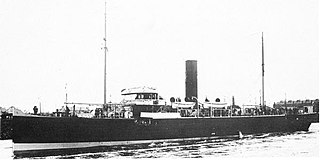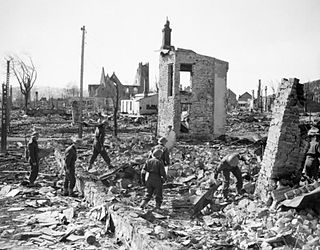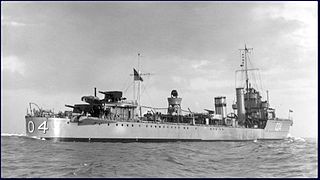
Q-ships, also known as Q-boats, decoy vessels, special service ships, or mystery ships, were heavily armed merchant ships with concealed weaponry, designed to lure submarines into making surface attacks. This gave Q-ships the chance to open fire and sink them.

Lieutenant Commander Malcolm David Wanklyn, was a Royal Navy commander and one of the most successful submariners in the Western Allied navies during the Second World War. Wanklyn and his crew sank 16 enemy vessels.

Lieutenant Commander Gerard Broadmead Roope was a posthumous British recipient of the Victoria Cross, the highest and most prestigious award for gallantry in the face of the enemy awarded to British and Commonwealth forces.

Captain Richard Been Stannard, was a British sailor, officer in the Royal Naval Reserve (RNR), and a recipient of the Victoria Cross (VC), the highest award for gallantry in the face of the enemy that can be awarded to British and Commonwealth forces. Stannard was awarded the first VC to the RNR in the Second World War.

The Namsos campaign, in Namsos, Norway, and vicinity took place between Anglo-French and Norwegian naval and military forces against German military, naval and air forces in April and early May 1940. It was one of the first occasions during the Second World War when British and French land forces fought the German Army.
HMT Warwick Deeping (H136) was a naval trawler of the British Royal Naval Patrol Service during World War II, sunk off the Isle of Wight in October 1940.

Admiral of the Fleet Roger John Brownlow Keyes, 1st Baron Keyes, was a British naval officer.
Seven vessels of the Royal Navy have been named HMS Arab:

HMS Sportsman was a third-batch S-class submarine built for the Royal Navy during World War II. Completed in 1942, she spent most of the war serving in the Mediterranean Sea. After an initial patrol off Norway, she sank the heavy transport Général Bonaparte in the Mediterranean in 1943 and missed a French oil tanker. She was heavily damaged after a mistaken attack by an Allied bomber, and was sent east after repairs to participate in operations in the Black Sea. After the operation was cancelled, Sportsman patrolled the Aegean Sea, sending several Greek and German ships to the bottom. She sank the German transport SS Petrella in early 1944 despite it being clearly marked as a prisoner-of-war ship, killing 2,670 out of 3,173 Italians aboard. Sportsman sank several more ships, and suffered minor damage when she was detected and sighted while attempting to attack a convoy.

HMS Fortune was one of nine F-class destroyers built for the Royal Navy in the mid-1930s. Although she was assigned to the Home Fleet upon completion, the ship was detached to the Mediterranean Fleet to enforce the arms blockade imposed by Britain and France on both sides during the Spanish Civil War of 1936–39. Several weeks after the start of the Second World War in September 1939, Fortune helped to sink a German submarine. The ship escorted the larger ships of the fleet during the early stages of World War II and played a minor role in the Norwegian Campaign of 1940. Fortune was sent to Gibraltar in mid-1940 and formed part of Force H where she participated in the Battle of Dakar against the Vichy French. The ship escorted numerous convoys to Malta in 1940–41 until she was badly damaged by Italian bombers in mid-1941.

HMS Doon was a Hawthorn Leslie type River-class destroyer ordered by the Royal Navy under the 1903 – 1904 Naval Estimates. Named after the River Doon in western Scotland, she was the first ship to carry this name in the Royal Navy.

The Royal Naval Patrol Service (RNPS) was a branch of the Royal Navy active during both the First and Second World Wars. The RNPS operated many small auxiliary vessels such as naval trawlers for anti-submarine and minesweeping operations to protect coastal Britain and convoys.

Naval trawlers are vessels built along the lines of a fishing trawler but fitted out for naval purposes; they were widely used during the First and Second World Wars. Some, known in the Royal Navy as "Admiralty trawlers", were purpose-built to naval specifications; others were adapted from civilian use. Fishing trawlers were particularly suited for many naval requirements because they were robust vessels designed to work heavy trawls in all types of weather, and had large clear working decks. A minesweeper could be created by replacing the trawl with a mine sweep. Adding depth charge racks on the deck, ASDIC sonar below, and a 3-inch (76 mm) or 4-inch (102 mm) gun in the bow equipped the trawler for anti-submarine duties.
Naval trawlers were purpose-built or requisitioned and operated by the Royal Navy (RN), mainly during World Wars I and II. Vessels built to Admiralty specifications for RN use were known as Admiralty trawlers. All trawlers operated by the RN, regardless of origin, were typically given the prefix HMT, for "His Majesty's Trawler".

HMS Exmoor was a Hunt-class destroyer of the Royal Navy. She was a member of the first subgroup of the class, and saw service in the Second World War, before being sunk by German E-boats in 1941.

HMS Vancouver was a British V-class destroyer. She was launched on 28 December 1917; in July 1922 she accidentally rammed the submarine H24. She was renamed HMS Vimy in April 1928. She served with distinction during World War II, earning two battle honours and damaging or sinking three enemy submarines. The Royal Navy retired her in 1945 and she was scrapped in 1948.

HMS Lady Shirley (T464), also known as HMT Lady Shirley, was a fishing trawler requisitioned by the Royal Navy in 1940 and converted for anti-submarine warfare duties. She sank U-111 on 4 October 1941, capturing 44 of her crew. Lady Shirley was sunk herself on 11 December 1941, by a single torpedo from U-374.
Armed trawler Nelson was a British auxiliary warship which served during World War I. She was built in 1905 as the fishing smack G&E, operating from Lowestoft and registered as LT 649. In 1915 she was armed for defence against U-boat attack, and fought several actions against them. She was sunk in action on 15 August 1917. This action was fought between a German U-boat and two trawlers, Nelson and Ethel & Millie, off the English coast.
Horatio was a Shakespearian-class naval trawler, launched on 8 August 1940. She served in World War II as a minesweeper and was sunk by the German motor torpedo boat S-58 off Cap de Garde, near Bône, Algeria. Two crew members survived the sinking and were captured by the German navy.

HMS Alisma was a Flower-class corvette that served in the Royal Navy.














